Queering the museum
Our vision The collection What makes an object queer? Contemporary collecting Collection management Other initiatives References
The Museum acknowledges that Queer is still a derogatory and problematic term for some people. However, Queer has been reclaimed and adopted as an identity and an umbrella term for LGBTQIA+ people.
Queer people are in museums. They work in them, they visit them, and their stories and objects are collected by them. But yet they are all too often invisible or barely visible.
In 2019 the Museum was questioned as to its holdings of material related to LGBTQIA+ (Lesbian, Gay, Bisexual, Transgender, Queer, Intersex, Asexual, plus) people, places, and stories. After a thorough collection survey, the answer was…almost nothing. Further research revealed there is little representation of LGBTQIA+ stories in regional museum collections across Australia. Some State and National institutions have made efforts to represent LGBTQIA+ stories in their collections and exhibitions.
However regional stories, from small towns in which many queer people live and work, are often different, but also equally important.
Where LGBTQIA+ people are excluded from mainstream collecting institutions, independent queer-focused collections have formed. On a national scale, this includes the Australian Queer Archives, and more local efforts such as the Tropical Fruits archive in Lismore, the Northern Rivers LGBTIQ History Project, or significant private collections held by local community members.
A regional museum, such as Tweed Regional Museum, operates in an environment that allows a close and intimate relationship with the community it collects for, of, and by. Unlike larger institutions on a state and national level, this relationship produces a unique accountability and responsibility to the local community.
Our vision
Preserving stories, sharing history: building an inspiring museum about the people, places, environment and culture of the Tweed for the benefit and enjoyment of visitors and the diverse communities of the region.
The Museum recognised a failure to fulfil this mission and wants to challenge the perpetuation of heteronormative centred ways of knowing and being within its collections. The idea for Small Town Queer was born, to explore and collect queer history and stories from the Tweed, along with the challenge for Tweed Regional Museum to undergo a ‘queering’ of its policies, museological practices and collections. Small Town Queer offers the opportunity to work collaboratively on the ways in which Tweed Regional Museum can establish a practice of collecting, preserving and making accessible the history, stories and material culture of local LGBTIQA+ people.
Straight and narrow – the TRM collection
The current Collection came to be in 2004 by an amalgamation and transfer of ownership to Tweed Shire Council of the collections of the three local historical societies of Murwillumbah, Tweed Heads and Uki & South Arm. Each Society, wholly supported by volunteers, had been operating and collecting for many decades previously. A formal collection policy, along with a review of existing collections and processes overseen by professional museum staff employed by council, did not commence until 2005. These processes and procedures were progressive in terms of establishing, for the first time, a defined focus for collection acquisition and care consistent with widely used and recognised ‘best practice’. They also further imbedded many of the pre-determined assumptions and classifications inherent in ‘best practice’.
The amassed collection now includes over 18,000 objects and 50,000 photographs, as well as archives, research files and oral histories.
The Museum’s Collection is not unlike the typical regional museum found throughout Australia. Agricultural tools, evolving or superseded technology such as typewriters, sewing machines, and household items saved and collected over the last 50 years are a focus. Provenance (known history) for the majority of objects is scarce, non-existent or anecdotal. Themes of colonisation and regional progression are strong, with culturally diverse stories often overlooked and not recorded.
The Museum began to address these issues and uncover previously untold stories with research projects including:
- 2007 - The Other side of the World: International migration to the Tweed 1940s to 1960s
- 2009 - Families of Fortune: Chinese people in the Tweed
- 2011 - Sweet harvests: Stories from the South Sea Islander and Indian community
- 2011 - Caravans and Communes: Stories of settling in the Tweed in the 1970s and 1980s
- 2016 - Aboriginal Breastplates of the Northern Rivers: Contested recognition uncontested identity
- 2017 - Untold Stories: Living with ability
- 2020 - Land Life Culture
However there has not been a project specifically dedicated to the LGBTQIA+ community in the Tweed. The Museum has also never examined how its procedures, policies, and established ways of working serve to perpetuate heteronormative approaches.
Collection survey
A collection survey in February 2020 produced only one oral history that mentioned an LGBTQIA+ community member and one object associated with a person who identified as a gay man. That is not to say there are no other items and stories, but rather it illustrates how the Museum’s curatorial focus, research focus, and classification system has not adequately recognised queerness.
The search for historical evidence of those who identify as having diverse sexuality and gender is often the task of trying to find people who did not want to be seen. Queer people have often hid their non-heteronormative identify to protect their reputation and personal safety.
The survey involved searching the collection database (Vernon CMS) using an open-ended range of historically specific markers. Using the classification system from the 2005 Victorian Lesbian, Bisexual, Gay, Transgender Collections Survey, Tweed Regional Museum used the following to survey for related material:
- Orientation: Direct relevance, e.g. identified individuals, material containing the words lesbian, gay, bisexual, transgender, queer or other historically specific terminology such as camp.
- Association: Icons or public figures, individuals associated with lesbian, gay, bisexual or transgender culture.
- Symbolism: Potential for subtext and queer readings. This included searching for LGBTQIA+ related prejudiced, stereotyped, and discriminatory language, as well as language used to indicate queerness as psychologically abnormal, such as “perversion”, and legal terminology, such as “sodomite”.
The challenge moving forward from the collection survey was to investigate how the Museum’s collection could represent the queer stories of the Tweed. One way is to focus on acquiring new material into the permanent collection to tell the LGBTQIA+ story of the Tweed, both historical and contemporary. It is hoped that Small Town Queer will result in generating new acquisitions to the Museum of LGBTQIA+ material. If you have photos, objects and/or documents you think may be suitable, please don’t hesitate to contact the Museum.
The second is to re-survey the existing collection through a different context; a queer lens. The third is to ensure that through changes in policy, practice and language that the historical invisibility of queer stories and perspectives in the Museum’s collection is not perpetuated.
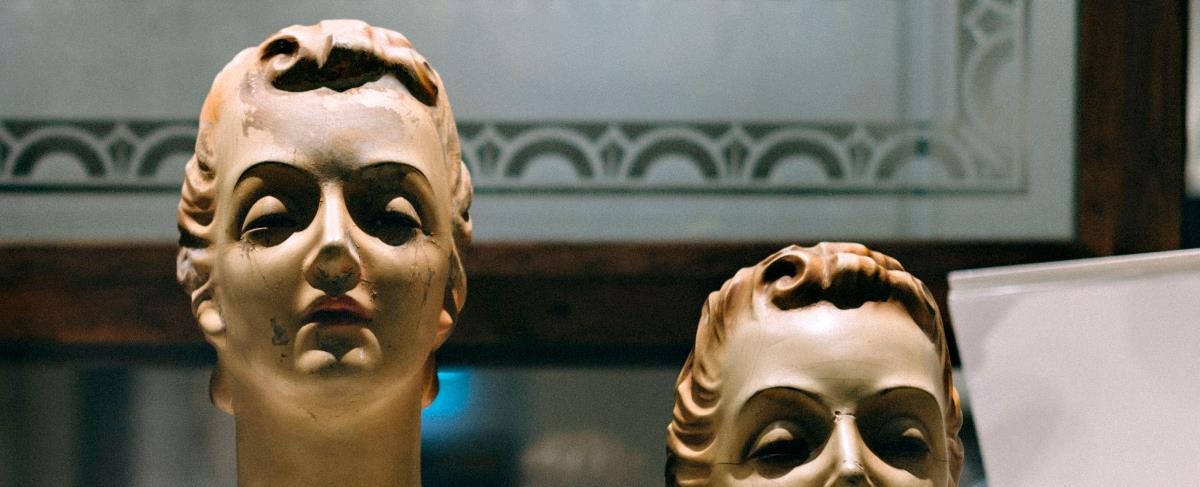
What makes an object queer?
The idea of ‘queering’ and queer objects is widely discussed and theorised academically. However, there are few examples from social history museums on how it has been applied. There are straightforward ways to think about queer objects as items that have been owned or used by LGBTQIA+ people or that deal with LGBTQIA+ issues. Examples would include a wig used by a famous drag queen, or a public health poster about HIV/AIDs targeted at gay men. While these remain significant objects to the LGBTQIA+ community, it’s necessary to understand that the queer perspective exists far beyond these obvious examples.
An object can be interpreted in multiple ways, which means potentially almost all objects can be used to explore a queer narrative. This is not an exercise in changing history, however it is possible for an object to tell a queer story, not from its provenance but directly through its interpretation. This notion of the process of interpretation being significant in this context recognises that those doing the interpreting in museums, often trained museum professionals, bring their own learned and ‘institutionalised’ biases and perspectives to how each object is described, catalogued and woven into the narrative of displays and other museum programs. These perspectives are often unconscious or unquestioned, and ‘close’ rather than ‘open’ the possibilities of interpretation.
The Queer perspective is therefore not only about questions of sexuality and gender. Queer/ing or "to queer" is a useful tool for opening interpretive inquiry and revisiting overlooked stories and objects of significance to queer identity. Using strategies such as re-contextualising, juxtaposition, and visual metaphors, it is possible to interpret a museum collection through a new lens to assist in the telling of LGBTQIA+ histories and stories.
The objects below have been chosen from the Tweed Regional Museum collection and have been reinterpreted through a queer lens by the curatorial team. The Museum has also invited members of the local LGBTQIA+ community to offer thoughts and interpretations of what these objects and photographs mean to them and what queer stories they might tell.
Dressing up
We often cannot conclusively define the gender and/or sexuality of a person in a photograph, or historical reference. This presents an opportunity for queering.
This image depicts two people at the Bray’s property at Kynnumboon, near Murwillumbah, sometime in the early 1900s. The Brays were one of the earliest European families to settle in the area. The image shows a man and woman wearing the conventional attire of the opposite gender. At the time this photo was taken there were certain laws against men appearing in women's clothing, outside of the theatre. The heteronormative assumption looking at this image is that perhaps they are brother and sister, or friends donning costumes purely for the photo opportunity. However through a queer lens the photo tells a story of gender play. Throughout the history of the Tweed examples of gender-bending parties can be found in the photographic record.
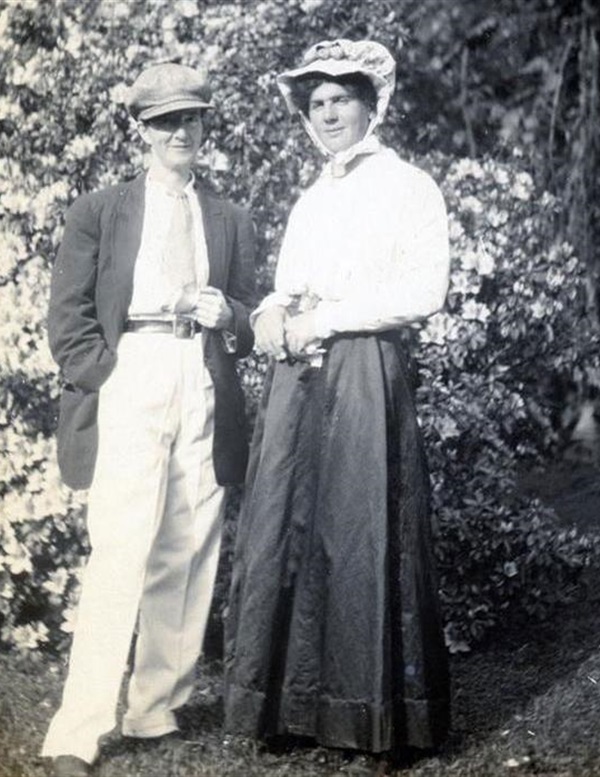 Two people at Kynnumboon. ID: 36737.
Two people at Kynnumboon. ID: 36737.
Dressing up in Murwillumbah in the early 1900s
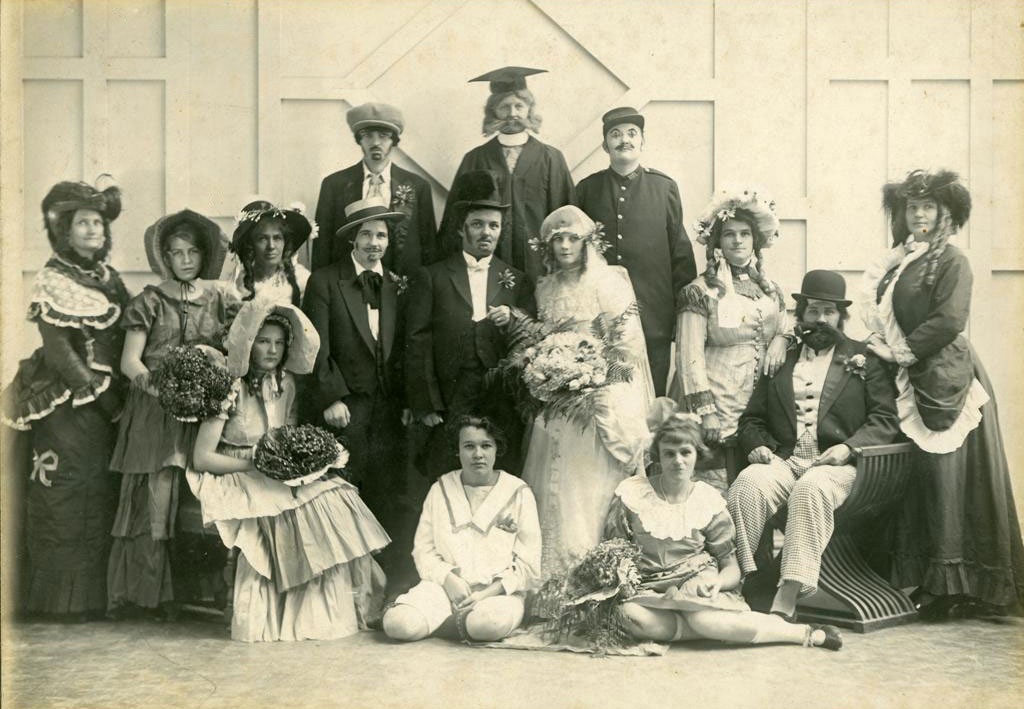
Group of people, Murwillumbah, photographer Angus McNeil, early 1900s. US000649.
Cross-dressing in the Tweed in the 1940s
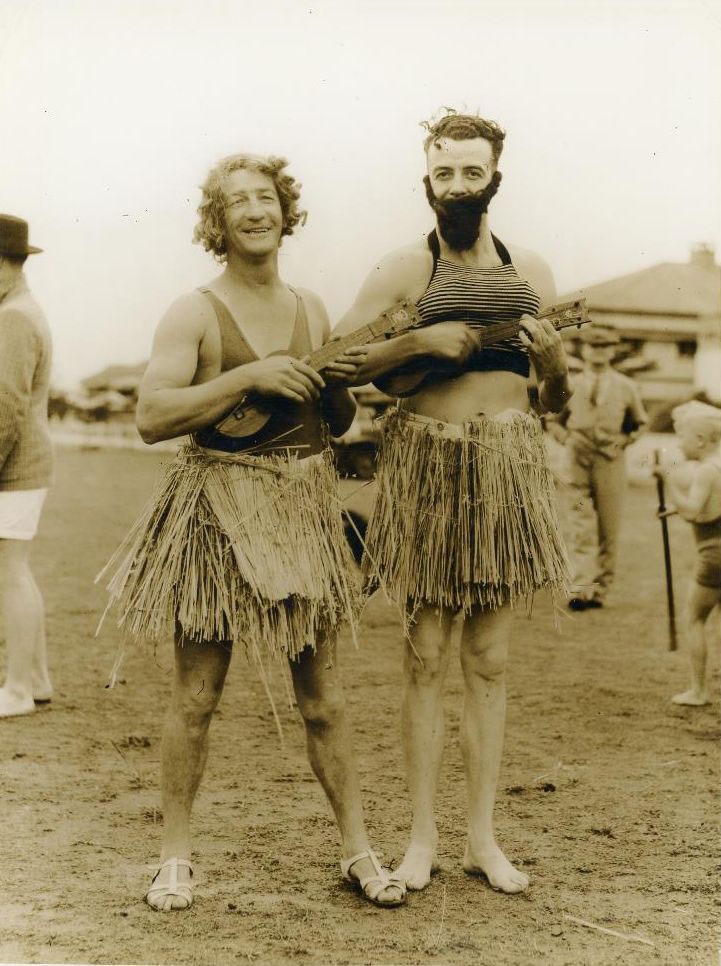
Two people dressed in grass Hula skirts, photographer Alfred Wappett, C. 1940s. MUS2018.24.168.
Story of two women
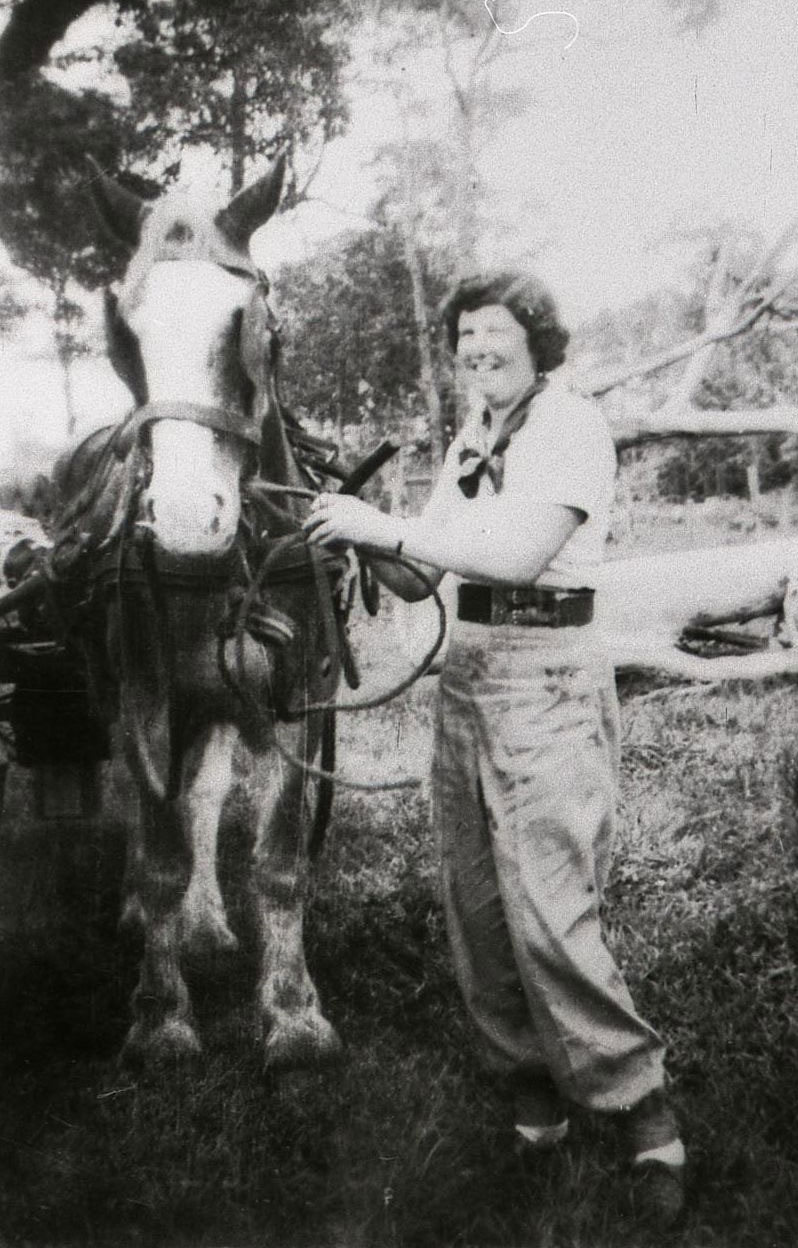 Woman with heavy horse
Woman with heavy horseThese two images, circa 1945, were donated to the Museum with the description telling us the woman is one of two English women who had travelled in the wagon from Sydney to Tweed Heads. They had brought the horse to local horseman, Jim Soorley, for attention. It is noted that Jim then allowed them to park their wagon on his property, where the women lived together in the wagon for about 5 years. While not enough evidence exists to call this relationship homosexual, to assume it isn’t is heteronormative. The story of the two women can certainly be used to discuss intimate female friendships and the advent of ‘Boston Marriages’, a late 19th century term which described two woman living together independent of financial support from a man.
"When I saw this set of photos I immediately became excited and imagined these two women defying all convention and living out their life together in a committed relationship while being on a great adventure as well! There is such a strong need for me as a gay man to believe that we existed in rural areas prior to the 1950s despite there being virtually no record of our existence other than as criminals and deviants sensationalised and demonized in the newspapers!
Confirmation of (LGBTIQ) individuals being here, that my community is/was/continues to be here and confirmation that we belong here in the Tweed region.”
Ian Gray
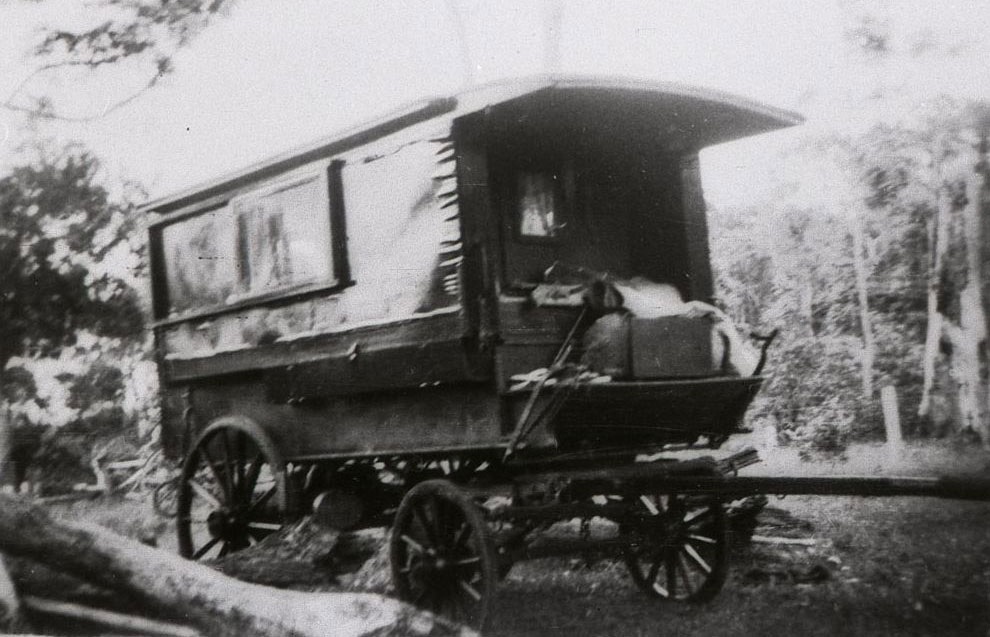
Gypsy style wagon, 1946. TH142-02, 03
Theatre advertising
These colourful slides from the 1950s were used in a local cinema to advertise upcoming feature films. They could also be used to examine a change in language over time, the word ‘gay’ once meaning high spirited, then at one time, being claimed by the male homosexual community, but also used as a homophobic slur.
Theatre advertising slides used at the Capitol Theatre Coolangatta and Empire Theatre Tweed Heads, 1950s. ID: 16182, 16155
The perfect woman
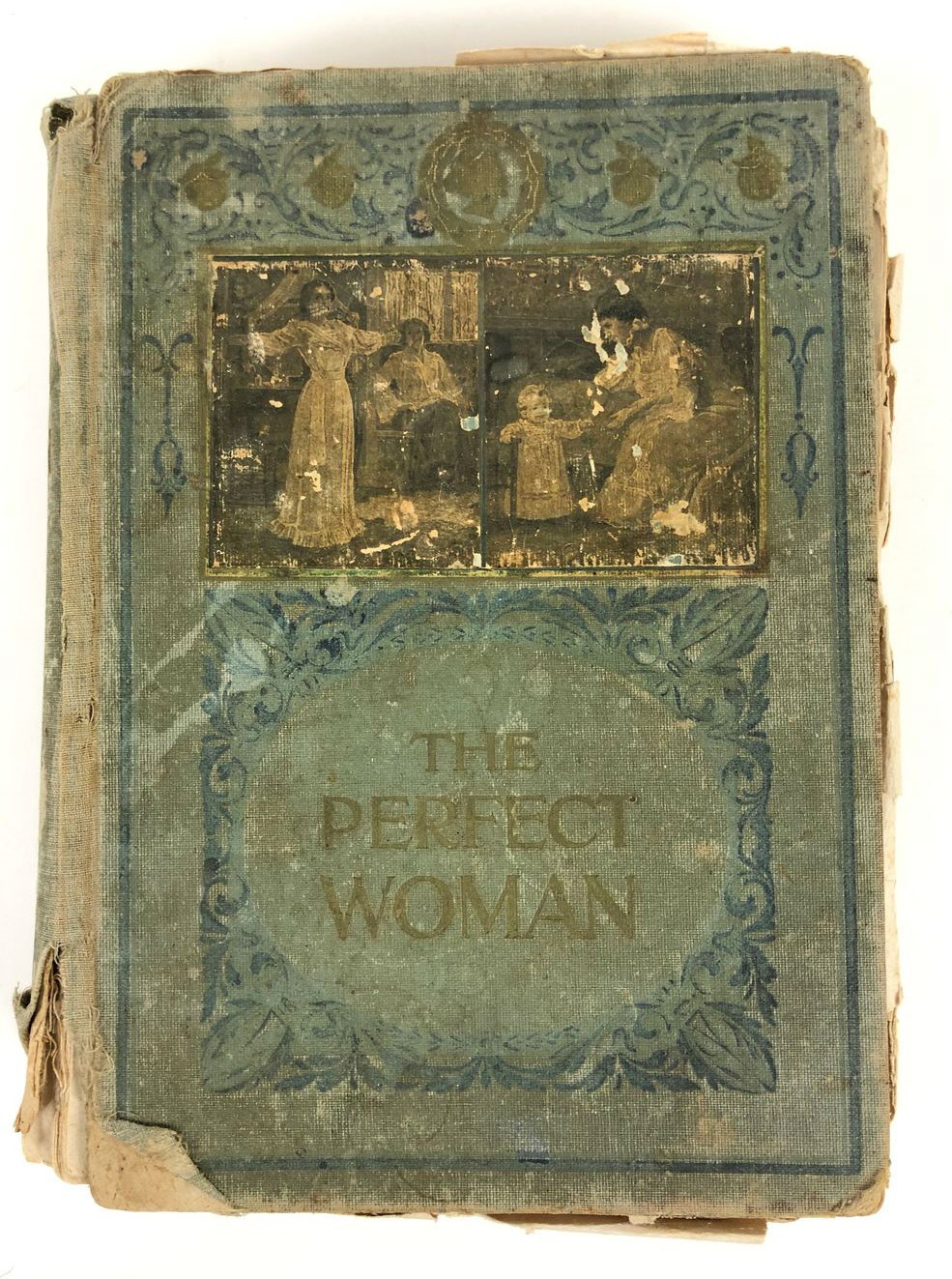 Book, The Perfect Woman, 1903. ID 36489
Book, The Perfect Woman, 1903. ID 36489This book dates from the early 1900s, typically aimed at young female readers, to educate about cleanliness, health, wellbeing, and propriety. Its ‘queerness’ is in juxtaposition; it could also act as a manual for someone who identifies with being female, someone who questions their assigned gender identity.
Leather harness
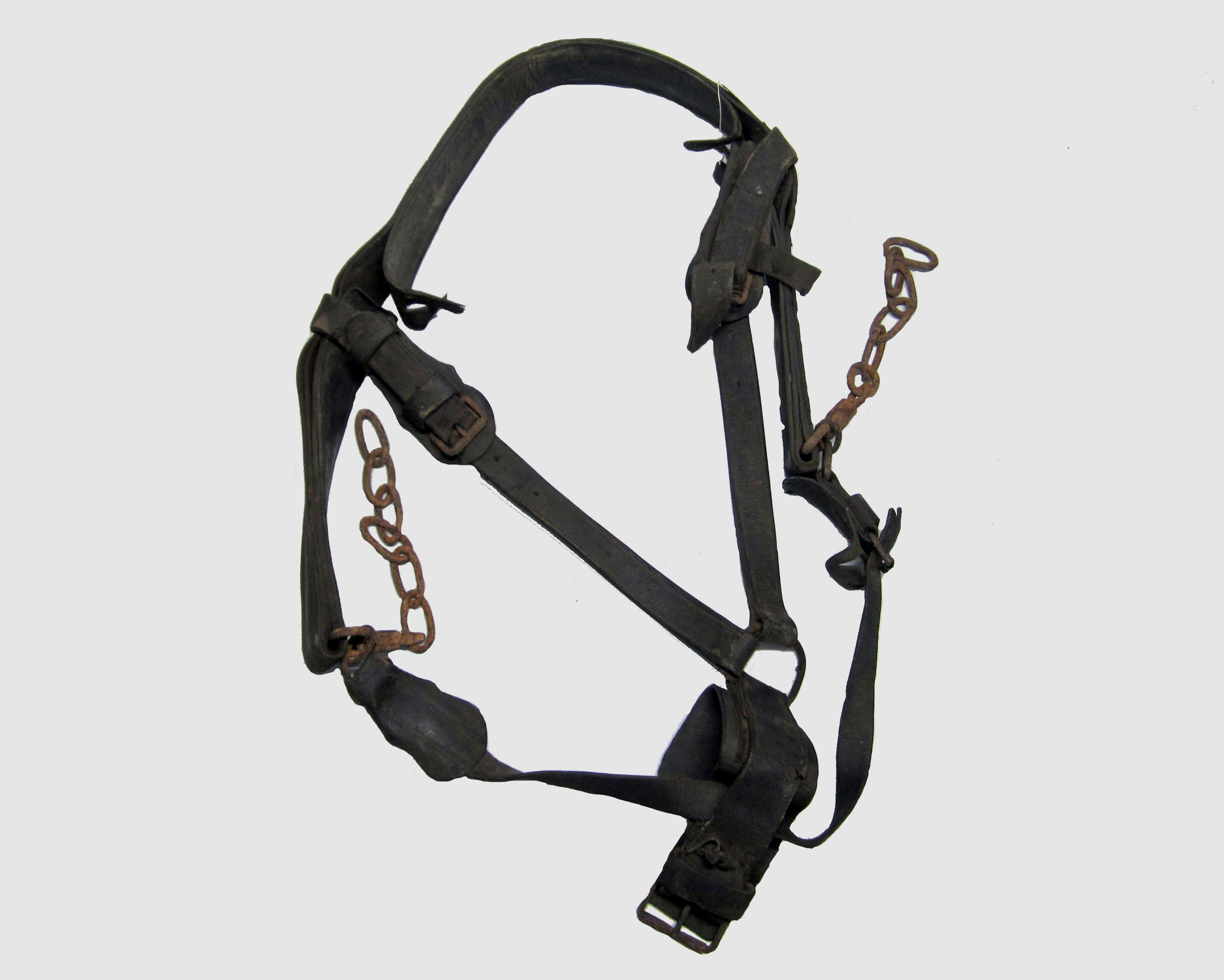 Harness, ID: 21512
Harness, ID: 21512While this leather harness has no provenance it can be used as a strong visual aid to tell a story of queerness. Leather harnesses have become synonymous with certain sub-tribes in the queer community. They are often used and worn to represent strength, masculinity, butchness, and also feature in various fetish scenes.
Binding bandage
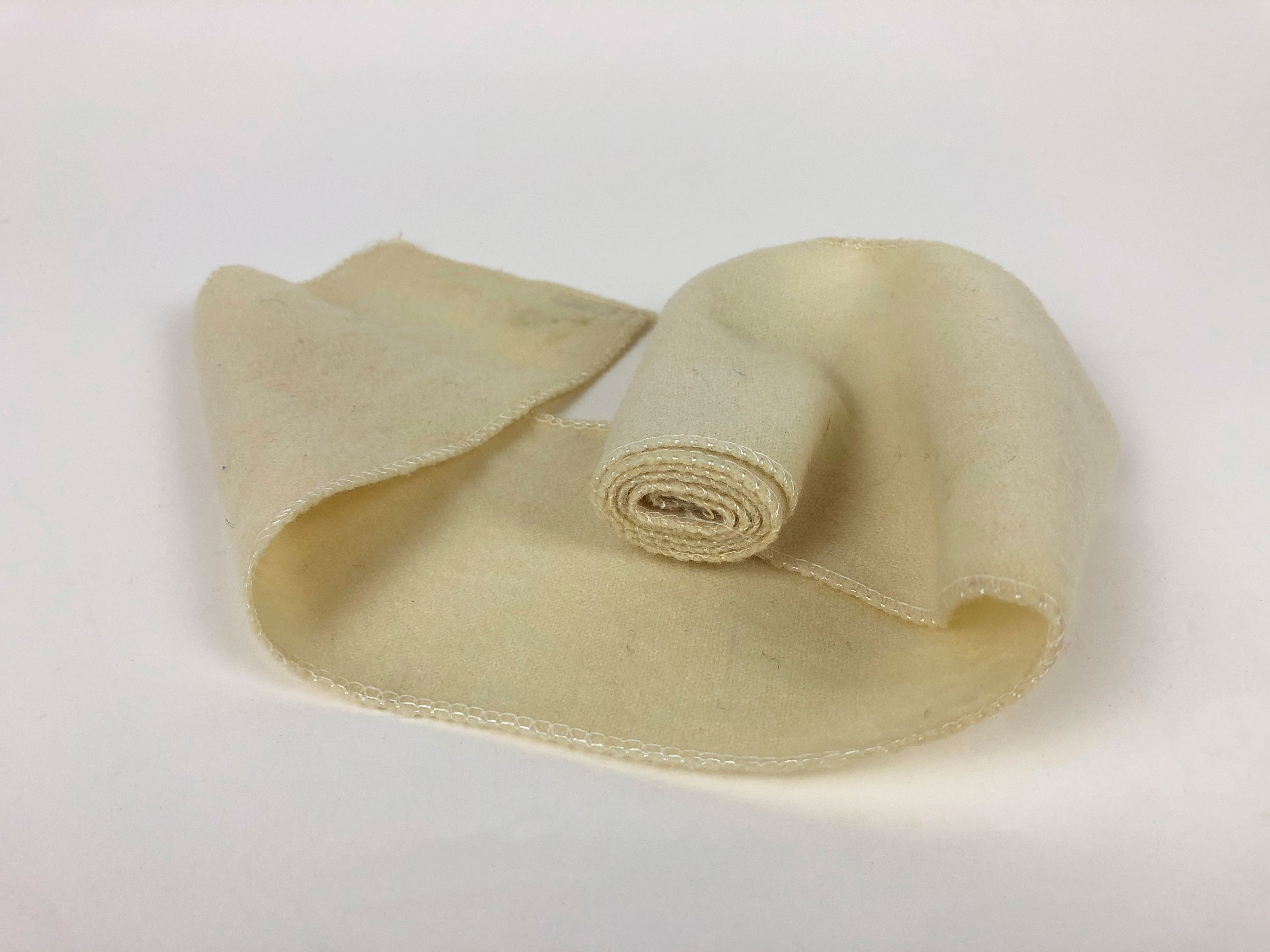 Binding bandage. ID:42004
Binding bandage. ID:42004This binding bandage was used on a child to bind around the waist after birth to invert the belly button. Binding bandages are also regularly used by trans men to repress a protruding chest.
Scythe
Scythes are common objects found in regional museums, typically used to tell a story of agriculture. A scythe was also used as a very strong visual symbol in television commercials in 1987, as part of a major public health campaign for HIV/AIDS. The ads featured the Grim Reaper wielding a scythe in a bowling alley, knocking down victims. The message of the campaign stated “At first only gays and IV drug users were being killed by AIDS, but now we know every one of us could be devastated by it.” It was a highly successful public health campaign, however some members of the gay and lesbian community felt that the symbol of the Grim Reaper and scythe came to be seen as representing HIV/AIDS infected gay men, contributing to the stigma of those living with the disease.
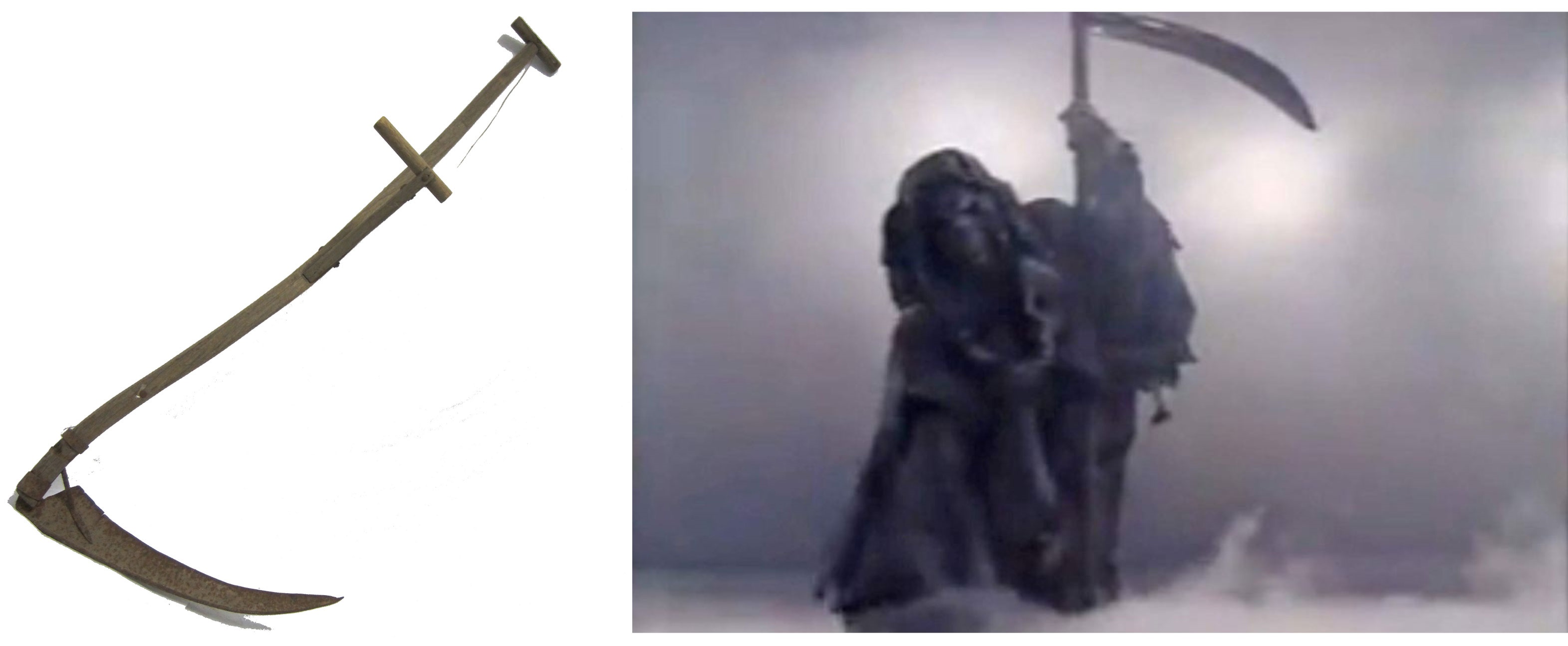
Scythe ID:30298. Screenshot from the 1987 HIV/AIDS television commercial ID:30298.
Men's sexual health
Objects can be open to multiple interpretations. Both these objects are most likely military issue, designed to combat the rise in venereal disease in soldiers during WWII. They could also be viewed as the tacit acknowledgement of homosexuality within the military, and the policing of suspected ‘queer’ soldiers. Furthermore, the booklet reinforces gender stereotypes with its masculine assertions, leading to discussions about masculine / feminine gender-binaries.
These images of condoms and packaging are camp and one image certainly alludes to potential ‘same on same’ male action! I do love the promotional claim that a condom may prevent nervous strain. In the context of HIV/AIDS the condom was for a long time our only hope, and indeed did alleviate some of the nervous strain around contracting or passing on the virus. I like the proactive health elements proffered because we men often tend to close our eyes and hope for the best. Anything that acknowledges sex and supports sexual health is a winner in my books!
Tobin Saunders: performer, educator, activist and professional show-off.
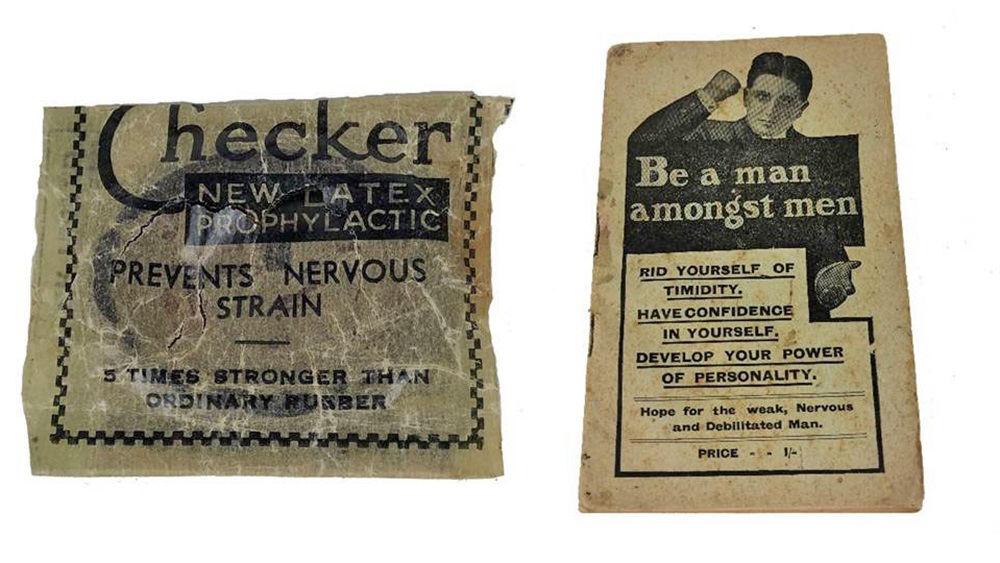
Condom and men’s sexual health booklet, 1940s. ID:28534 ID:28533.
Contemporary collecting
The Museum is focused on collecting oral history, objects, and material from project participants of Small Town Queer. Newly acquired objects and their stories are shared below.
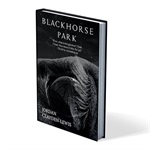 Released in 2019, Blackhorse Park is the debut novel by local writer Jordan Clayden-Lewis.
Released in 2019, Blackhorse Park is the debut novel by local writer Jordan Clayden-Lewis.
You can read more about Jordan on the Queer icons page.
Collection management
Research and development of this project has allowed the Museum to take a broader look at collection management and development, and rethink how we do things in order to uncover different stories and be a repository for queer objects. The following new initiatives have been outcomes of this project:
- The Museum’s Collection Policy sits at the core of how and why we collect. The policy is being revised to include local LGBTQIA+ stories in the listed themes of focus. (section 1.3.2)
- Tweed Regional Museum currently uses Vernon cataloguing software. Investigations for options to record sexuality and pronouns in Vernon revealed there were none; this is now being rectified. The Museum is working with Vernon Systems to provide capacity for this in a future upgrade of the software.
- The Museum has modified its cataloguing system (Vernon) to extend the classification of gender in the CMS beyond male/female.
- A special classification of “Queer Collection” was created in the CMS and is to be used for future acquisitions when collected for their association to LGBTQIA+ people and stories.
Other initiatives
- To successfully deliver Small Town Queer, Museum staff recognised the need to include queer knowledge and expertise that was beyond the current abilities of staff. The Museum worked with external contributors and collaborators to bring the project to fruition.
- All Museum staff participated in ‘Pride in Diversity’ LGBTQ Awareness training provided by ACON to assist in organisational change and workplace diversity. This training will be provided to all new staff members of Tweed Regional Museum. All front of house Museum volunteers are currently being offered the same training.
- In addition to formal training, curatorial staff developed ‘bite-sized’ training, delivered to the wider Museum staff via email on a weekly basis. This included things such as snippets of the project as it developed, links to short educational videos, and infographics aimed at increasing awareness of current LGBTQIA+ perspectives.
- The Museum participated in the Welcome Here project.The Welcome Here Project offers the opportunity for local organisations to sign up to become a registered ‘Safe Place’. Rainbow stickers are now displayed on the Museum’s front doors, which identifies the Museum as a place where LGBTQIA+ diversity is welcomed and celebrated.
- The Museum surveyed how it collects information about gender, which was found to be inappropriate at times. All Museum forms and surveys where gender was an option were changed to ensure the options were not exclusionary or harmful.
- The Museum supports international and national diversity days through its social media and programming activities. It also supports local events such as the Tweed Heads Diversity March, which is an annual event that occurs in October organised by the Compass Youth Network, Tweed Heads.
References
- A. Barry, ‘Trans erasure, trans visibility: History, archives, and art’, Archer, 6 Nov 2018. http://archermagazine.com.au/2018/11/trans-erasure/ (accessed 23 July 2020).
- K. Davison, ‘Lesbian, Gay, Bisexual & Transgender Project Museum Victoria 2005-2006’, Museums Victoria, [website], 2006, https://collections.museumsvictoria.com.au/articles/2730 (accessed 23 July 2020).
- J. Lymn and S. Leah, ‘What makes an object queer? Collecting and exhibiting LGBT stories in regional museums and archives’, Proceedings of RAILS - Research Applications, Information and Library Studies, New Zealand, Victoria University of Wellington, 2016.
- T. Nguyen, ‘Queering Australian Museums: Management, Collections, Exhibitions, and Connections’, PhD Thesis, The University of Sydney, 2018.
- A. Raker, ‘Visitors Aren’t Allowed Inside Closets: The Mislabelling and Hiding of LGBT People in Museums’. Marie C. Malaro Excellence in Research and Writing Award Symposium, Washington D.C., 2013.
- N. Sullivan and C. Middleton, Queering the Museum, Oxon, Routledge, 2020.